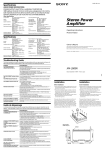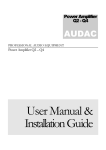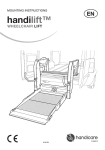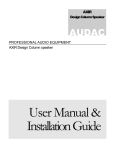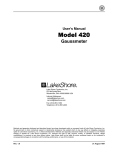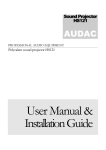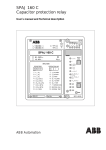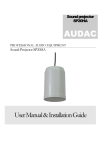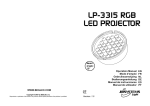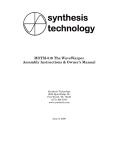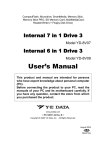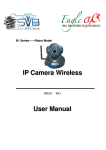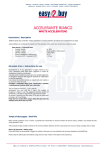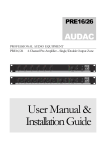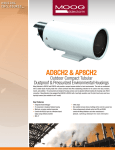Download Illegal Version of pdfFactory Pro
Transcript
APM 01 / 04 / 08 / 016 ARU / AVD 04 / 08 / 16 AUDAC PROFESSIONAL AUDIO EQUIPMENT 1/4/8/16 Zone Digital Paging Station (APM), 4/8/16 Digital Receive/Switch Module (ARU/AVD). User Manual & Installation Guide AUDAC Professional audio equipment User Manual & Installation Guide AUDAC http://www.audac.be [email protected] Index INTRODUCTION ..............................................................................................................................................................................................................................2 APM PAGING TABLE:........................................................................................................................................................................................................................2 ARU/AVD RECEIVE /SWITCH MODULE :.............................................................................................................................................................................................4 T HE AVD MODULE:...........................................................................................................................................................................................................................5 ACCESSORIES APM PAGING TABLE .........................................................................................................................................................................................6 SAFETY REQUIREMENTS .............................................................................................................................................................................................................7 CAUTION - SERVICING ................................................................................................................................................................................................................7 OVERVIEW DIFFERENT APM MODELS ....................................................................................................................................................................................8 APM 16: ...........................................................................................................................................................................................................................................8 APM 08: ...........................................................................................................................................................................................................................................8 APM 04: ...........................................................................................................................................................................................................................................9 APM 01: ...........................................................................................................................................................................................................................................9 OVERVIEW DIFFERENT ARU / AVD MODULES ....................................................................................................................................................................11 ARU4 .............................................................................................................................................................................................................................................11 ARU8 .............................................................................................................................................................................................................................................11 ARU16 ...........................................................................................................................................................................................................................................11 AVD4 .............................................................................................................................................................................................................................................12 AVD8 .............................................................................................................................................................................................................................................12 AVD16 ...........................................................................................................................................................................................................................................12 RJ-45 PIN CONNECTIONS............................................................................................................................................................................................................13 ATTENTION .................................................................................................................................................................................................................................13 POWER SUPPLY.............................................................................................................................................................................................................................14 M AXIMUM RATED CURRENT ............................................................................................................................................................................................................14 V OLTAGE DROP ACROSS THE CABLE ................................................................................................................................................................................................14 GETTING STARTED ......................................................................................................................................................................................................................15 APM: ..............................................................................................................................................................................................................................................15 ARU: ..............................................................................................................................................................................................................................................16 C ONNECTIONS ARU08 ....................................................................................................................................................................................................................17 J UMPER SETTINGS FOR AUDIO ROUTING ...........................................................................................................................................................................................18 AVD:..............................................................................................................................................................................................................................................19 C ONNECTIONS AVD8:.....................................................................................................................................................................................................................19 WORKING PRINCIPLES OF ARU/AVD IN COMBINATION WITH APM ............................................................................................................................20 POSSIBILITY 1: APM01 DIRECTLY ON A PRIORITY INPUT OF AN MIXING AMPLIFIER ..........................................................................................................................20 POSSIBILITY 2: IN LARGER INSTALLATIONS WHERE THERE IS AN AMPLIFIER FOR EACH ZONE. ( SWITCHING ON LINE LEVEL) .............................................................21 POSSIBILITY 3: SWITCHING ON LINE LEVEL, INCLUDING EMERGENCY C ALL ON VOLUME CONTROLS. ..............................................................................................22 POSSIBILITY 4: U SING TWO SEPARATE AMPLIFIERS FOR MUSIC AND PAGING.....................................................................................................................................23 POSSIBILITY 5: SWITCHING ON LOUDSPEAKER LEVEL, WITH EMERGENCY C ALL ON V OLUME C ONTROLS. ........................................................................................24 WIRE UP THE SYSTEM ................................................................................................................................................................................................................25 ARJ3 MODULE : ...............................................................................................................................................................................................................................25 BUS STRUCTURE ........................................................................................................................................................................................................................26 ONE STARPOINT .........................................................................................................................................................................................................................26 MULTIPLE STARPOINTS............................................................................................................................................................................................................27 ADVANCED OPERATION APM...................................................................................................................................................................................................28 CONFIGURATION OF THE ARU/AVD MODULES ..................................................................................................................................................................31 ADDITIONAL INFORMATION APM/ ARU/ AVD .....................................................................................................................................................................32 PINOUT RS485 AUDAC PAGING SYSTEM FOR DEVELOPMENT PURPOSES .....................................................................................................................32 CONDENSATOR MICROPHONE A UDAC CMS45 ......................................................................................................................................................................33 M ECHANICAL INFO ARU/AVD .......................................................................................................................................................................................................33 PERSONAL NOTES ........................................................................................................................................................................................................................34 Introduction This section describes briefly the functionality of the APM/ARU/ AVD paging system. T he Audac Paging System is developed as a simple, flexible solution for evacuation and paging systems. APM Paging Table: This table microphone with zone-selection is equipped with a digital audio memory which allows storing all necessary ‘gong’ signals. The gooseneck microphone is equipped with a electret capsule with cardiöd sound pattern. A build in Compressor/Limiter with Automatic Gain Control controls the output level of the unit. On the front plate there is also an indication which gives the person who’s talking an impression of his voice level. The complete operation, from microphone till the output including all digital parts, are guarded. In case of malfunction, there is a fault-indication. This is to make sure that when there is an emergency call, the message arrives by the listeners. When there are several paging units placed in a bus-structure, one can configure them with different priority levels. The status of the audio-bus is indicated on the front panel (enable led). All these configurations can be made in a very simple way with the free software tool “the AUDAC CONFIGURATION MANAGER”. This tool can be downloaded for free on the AUDAC website (www.audac.be). There are 4 basic models: - APM 01: Paging Unit just for General announcement. - APM 04: Paging Unit with for Zone Buttons, ‘Select All’-, ‘Clear’- and ‘Talk’-button. - APM 08: Paging Unit with 8 Zone Buttons, ‘Select All’-, ‘Clear’- and ‘Talk’-button. - APM 16: Paging Unit with 16 Zone Buttons, ‘Select All’-, ‘Clear’- and ‘Talk’-button. The lower function buttons are standard programmed with following functions: “Select All” button, to activate all Paging Zones, “Clear” button, to deactivate all Paging Zones. The remaining buttons are used for Zone-Selection or other switch-functions. All the buttons are free programmable with the “AUDAC CONFIGURATION MANAGER”. 2 Following buttons are standard: - Talk: By pressing this button, the “gong” starts to play. After this, one can place an announcement through the microphone. - Select All: By pressing this button, all “Zone” buttons will be selected at once. - Clear: This button will deselect all selected “Zone” buttons. Following functions are free programmable: - Zone-select: This is for selecting a Paging Zone. Pressing again will deselect the Zone. By pressing “Talk” the selected Zone will be switched. - Power Up delay: This is a function for switching on/off several devices. The step-time is adjustable on the receive/switch unit with a small trimmer. - Pulse Relay: This function will, by pressing a button, activate a relay, and this relay keeps activated as long one keeps the button pressed. (Press and hold function) (e.g. To open a door with electrical door contact) - Toggle Relay: This function will, by pressing a button, activate a relay, and by pressing the button again, deactivate the relay (Set-Reset function) (e.g. Switching lights,… - Select Layer 0: It is possible by using layers (max. 3 layers) to expand the Paging Unit. By pressing this button, Layer 0 will be activated. - Select Layer 1: After pressing this button, layer 1 will be activated. - Select Layer 2: After pressing this button, layer 2 will be activated. In ‘Service mode’ following functions are available: - Volume Up (mic. of gong): With this function button one can increase the volume (microphone or gong) with steps of 3dB (256 steps). - Volume Down (mic. of gong): With this function button one can decrease the volume (microphone or gong) with steps of 3dB (256 steps). - Select mic.: By pressing this button one selects the microphone to change its volume. - Select gong: By pressing this button one selects the gong to change its volume. The standard used bus protocol is RS-485, but with an extra plug-in card other bus standards are also available (e.g. LON,…) 3 ARU/AVD Receive/Switch module: The Audac ARU/AVD Receive/Switch modules are designed for use with the AUDAC APM01/04/08/16 paging stations. The modules communicate over RS485 and have 4/8/16 relays for several switching tasks. Following modules exists: - ARU4: This module can switch between 2 signals (background music and Paging Microphone) and is equipped with 4 relays (4 different zones) - ARU8: This module can switch between 2 signals (background music and Paging Microphone) and is equipped with 8 relays (8 different zones) - ARU16: This module can switch between 2 signals (background music and Paging Microphone) and is equipped with 16 relays (16 different zones) - AVD4: This module can switch a common signal (e.g. 24VDC) to 4 different outputs. (Activating emergency call relay, triggering power relays for curtains,…) - AVD8: This module can switch a common signal (e.g. 24VDC) to 8 different outputs. (Activating emergency call relay, triggering power relays for curtains,…) - AVD16: This module can switch a common signal (e.g. 24VDC) to 16 different outputs. (Activating emergency call relay, triggering power relays for curtains,…) 4 The ARU module: This module is designed for switching between 2 signals (background music and Paging). There are 4, 8 and 16 channel modules. The module is made very flexible. It is for example possible to use for each zone separate music sources, or use 1 common music source for all Paging Zones. All combinations in between are possible. The connections which have to be made for this can be done in a very simple way by setting ‘jumpers’. In case of large installations, the ARU modules can be placed in cascade and addressed by the Configuration Software. The module is suitable for mounting on a DIN-rail. On one side there are the ‘fixed connections’ (e.g. Amplifiers, …). On the other side there are the ‘field connections’ (e.g. Loudspeaker cables, CAT5 bus cable,…). This way of working allows a quick, proper cabling of the system. The AVD module: This module is designed for switching 1 common signal to the output. There are 4,8 and 16 channel modules. The module can be used for following purposes: - Activating the “Emergency Call” relay on a classic volume control. This is by switching 24V DC. - Activating power relays or teleruptor for triggering e.g. Window blinds, door contacts, ... - Power on delay: In case of heavy equipment where the turn-on current is too large (e.g. 8 amplifiers of 4000Watts), we can switch them on in cascade. The delay time is adjustable by a small trimmer on the AVD unit. In case of large installations, the ARU modules can be placed in cascade and addressed by the Configuration Software. The module is suitable for mounting on a DIN-rail. On one side there are the ‘fixed connections’ (e.g. Amplifiers, …). On the other side there are the ‘field connections’ (e.g. Loudspeaker cables, CAT5 bus cable,…). This way of working allows a quick, proper cabling of the system. 5 Accessories APM Paging Table The APM 01/16 is standard equipped with a gooseneck microphone. Other parts: - Transparent bezels for buttons (APM16: 19pcs, APM08: 11pcs, APM04: 7pcs, APM01: 1pc) 6 1 Chapter Safety Requirements The APM 01/04/08/16 can be configured by the free software tool “AUDAC CONFIGURATION MANAGER”. This must be done by a qualified person. Do not open the units, unless you are qualified to do so. Remove the CAT5 cable before performing any servicing. The ARU/AVD 04/08/16 contains several ‘jumpers’ which can be set for a desired configuration. These settings may only be done by qualified people. Switch power off before changing any ‘jumpers’. G CAUTION - SERVICING This unit contains no user serviceable parts. Refer all servicing to qualified service personnel. Do not perform any servicing unless you are qualified to do so. Note This product conforms to the following European Standards: EN 50081-1: 1992, EN 50082-1: 1992, EN 60065: 1994, EN 60849 7 Overview different APM models APM 16: APM 08: 8 APM 04: APM 01: The figures above present al modules with their standard functions behind the buttons. 9 There are 4 standard models : - APM 16: Contains a 4x4 programmable button matrix and a row with basic functions. Standard the buttons have the following functions: Zone 1 – 16, Select All, Clear All, Push to Talk. - APM 08: Contains a 4x2 programmable button matrix and a row with basic functions. Standard the buttons have the following functions: Zone 1 – 8, Select All, Clear All, Push to Talk. - APM 04: Contains 4 programmable buttons and a row with basic functions. Standard the buttons have the following functions: Zone 1 – 4, Select All, Clear All, Push to Talk. - APM 01: Contains 1 single button: Push to Talk (General announcement). It is possible to reprogram all function buttons. This can be done by the configuration software. There are also 4 indication leds with following functions: Orange LED: Bus status (enable), and flashes when the gong is played. Green LED: Voice level indication while speaking. The green LED means: Voice level is OK. Red LED’s: These LED’s will light up in case the voice level is too low or too high. In case of any malfunction (e.g. Microphone is broken), the green end red LED will start to flash. By this way, one can always see if the Paging Table is working properly. 10 Overview different ARU / AVD modules ARU4 ARU8 ARU16 11 AVD4 AVD8 AVD16 12 RJ-45 pin connections The APM/ARU/AVD Series are connected by a CAT5 cable. The units need a 24V DC power supply. The 24V DC is connected to the ARU/ AVD module. On every ARU/AVD module there are 2 RJ45 sockets. By these sockets, the units are connected in a bus structure by a CAT5 cable. The connections are as described below: $ ATTENTION Pin 1 White-Orange LON A (optional) Pin 2 Orange LON B (optional) Pin 3 White-Green +24V DC Pin 4 Blue RS485 A Pin 5 White-Blue RS485 B Pin 6 Green Pin 7 White-Brown Audio S+ Pin 8 Brown Audio S- GND The Cat5 cabling must always be ‘straight’. In case of self made cabling, it must be done as described above, to make the system work properly. For creating easy a bus structure, there are “ARJ03 splitter” modules (AUDAC). These will be described later. 13 Power supply Normally, the power supply must be connected only at one ARU-, AVD- or splitter module. The other modules of the paging network will be fed through the CAT5 cable. Maximum rated current The power supply’s maximum rated current must be higher then the sum of the currents of the connected modules. If the sum exceeds 2A, it is best to use an extra power supply instead of using a power supply with a larger maximum rated current. For example: an APM module uses +/-300mA, an ARU/AVD/4/8 uses +/-200mA and an ARU16/AVD16 uses +/-400mA. Choosing the right 24V DC power supply : E.g.: We have 2x ARU8 modules, 1x AVD16 module and 3x paging stations. This means a total of 200+200+400+300+300+300 = 1.7 Ampere at 24V DC. In this case we recommend a power supply of at least 2A at 24V DC. Voltage drop across the cable In case of a large number of modules (ARU-, AVD modules and paging stations) and/or large cable distances, voltage loss across the CAT5 cable can occur. In this case some extra power supplies must be placed in the system. These power supplies can be connected to ARU-, AVD- or splitter modules. Always make sure the power supply at the ARU-AVD modules and paging stations does not drop below 16V due to voltage drop across the cable. A simplified calculation method can be used: Allowable voltage drop over the cable: Vdrop = 8V Average Cable resistance of UTP CAT5e cable: Rcable = 0.096 ohm/meter Average current of a module: Iav = 0.3A Number of modules: x Cable length: L (in meters) Simplified formula: Vdrop = L * Rcable * Iav * x So maximum cable length L = Vdrop / ( Rcable * Iav * x) If we fill in the parameters we become: L = 277 / x , with x the number of connected modules. For example: if we have 6 modules connected to one power supply, the maximum total cable length of the databus is L = 277 / 6 = 46 meters. 14 2 Chapter Getting Started APM: When turning the power on, the APM paging station comes into its “USER MODE”. In this mode we have function buttons (in most cases Zone buttons, 4-8-16), 1 “Select All” button, one “Clear All” button and a “Talk” button. When selecting a zone, the button will light up “green”. When pressing again, the green led will go out. One can select all Zone, simply by pressing ”Select All” and deselect all made settings by pressing “Clear All”. To make an announcement, press “Talk” and keep pressed. This can only be done in case the audio bus is free (not in use by another paging Station (Yellow LED may not light up). Following actions take place: - All selected zones will be transmitted to the ARU/AVD receive units and the relays will switch, - Next step is the playing of the “gong” signal. During this, the “enable” led flashes. - If the “gong” signal is terminated, the “enable” LED stops flashing, and the “LOW” LED will light up and the microphone is turned on. From that moment the announcement can begin. The best way to speak trough the microphone is on a distance of +- 5cm, and a voice level so the “green” LED (Level = GOOD) lights up. - To terminate the announcement just release the “Talk” button. - From that moment one can change the selected zones for the next call. The APM01 has only a “Talk” button which is used to make a general announcement (All zones). It is also possible to specify a number of zones. This must be done in the Configuration Manager Software Tool. 15 ARU: The figure below shows the meaning of the connections of an ARU8 module. For the ARU4 and ARU16 module it is the same. Zone output Analogue relay activation 2x RJ45 (DataBus) Jumpers for Audio Routing Input Channels B (Paging) Input Channels A (Music Source) 16 24V DC Connections ARU08 Zone output: This is where the signals A and B are switched to for each zone. Input Channel A: This input is standard selected. This is for connecting the signal of a music source. Input Channel B: This is where the signal of the Paging Table(s) must be connected. By disconnecting the power (e.g. Fault) this input will be passed trough. 24V DC: The systems needs 24V DC power. See part “Power supply and pin configuration” for more explanation. Line output APM: This is the line level signal of the paging table(s). This signal must go to an amplifier. There are different way’s to do this. (See next Chapter). Jumpers for Audio Routing: With this jumpers audio routings are made very simple. This saves extra external cabling. Analogue relay activation: This makes it possible to activate a relay simply by pulling a contact to the ground. (e.g. with pushbutton,…). 2 x RJ45 (Databus): The databus and DC power of all modules is distributed trough the CAT5 cable. To guarantee proper operation, cabling must be “Daisy-chain”. The front and the end of the bus must be terminated with a resistor (+-120 Ohm). This can be done on the last RJ03-splitter module by setting a jumper. (See further in this manual) 17 Jumper settings for audio routing In this example 3 jumpers are set. The jumper on the right side above input “IN_1” connects the left channel of “IN_1.A” to the right channel of “IN_1.A” (blue tracks). The second jumper can be used to connect the left channel of input channel IN_1.B to the right channel of IN_1.B. Each input channel A and B has its own jumper. The two jumpers on the right side connect “IN_7.A.right” with “IN_8.A.right” (top jumper, green tracks) and “IN_7.A.left” with ”IN_8.A.left” (second jumper, purple tracks). The third jumper can be used to connect “IN_7.B.right to ”IN_8.B.right”, and the fourth jumper can be used to connect “IN_7.B.left” with ”IN_8.B.left”. As you can see it is possible to connect an input channel A or B to a previous and/or next input channel A or B. As you can see a lot of combinations are possible. In the example above the A input channels are used but it is also possible to use the B input channels. 18 AVD: Output signal Common switch signal Analog relay activation 2x CAT5 (Databus) 24V DC Connections AVD8: 24V DC: The systems needs 24V DC power. See part “Power supply and pin configuration” for more explanation. Common switch signal: This is for connecting the common signal which one wants to switch. (e.g. 24V DC or Paging signal) Output Signal: This is where the common input signal is switched to. Analogue relays activation: This makes it possible to activate relay’s by pulling the contact to ground. (e.g. with push button) 2 x RJ45 (Databus): The databus and DC power of all modules is distributed trough the CAT5 cable. To guarantee proper operation, cabling must be “Daisy-chain”. The front and the end of the bus must be terminated with a resistor (+-120 Ohm). This can be done on the last RJ03-splitter module by setting a jumper. (See further in this manual for more information) 19 3 Chapter Working principles of ARU/AVD in combination with APM Following figures indicate working principles of APM tables with ARU/AVD modules. Possibility 1: APM01 directly on a priority input of an mixing amplifier The Paging Microphone input is connected to an override-input of a mixing amplifier. As option one can place an ARU or AVD module to activate Emergency Call relays, when there are volume controls in each room. 20 Possibility 2: In larger installations where there is an amplifier for each zone. (switching on Line Level) In this setup, the ARU module is placed in the Line Level circuit. One can place an announcement in every zone separately. With ARJ-03 splitter modules it is possible to connect more then 1 paging table to the system. Every paging table can have its own priority level. If there are more than 1 ARU modules used, the music sources must be connected to every ARU module. The paging signal is passed through the CAT5 cable, and must be connected to Input B on the ARU module. 21 Possibility 3: Switching on Line Level, including Emergency Call on volume controls. This is the same principle as in the previous case, accept the extra use of an AVD module for overriding the volume control in case of Emergency Call. In this case the music can be regulated at low level, without influence on the paging signal. 22 Possibility 4: Using two separate amplifiers for music and paging. In this setup we need an amplifier for the music signal and an amplifier for the paging signal. We can separate regulate the volume between these two. The power of the amplifier must be calculated on the total load of the system. In this configuration the great advantage is that there are only 2 amplifiers needed, even if there are more then 2 paging zones. Disadvantage is, that the volume is equal for each room. This can be fixed by placing volume controls in each room (with or without emergency Call). 23 Possibility 5: Switching on loudspeaker level, with emergency Call on Volume Controls. This is the same setup as previous, but with volume control for each zone. With an extra AVD unit it is possible to switch the Emergency Call of the volume Controls. This is by switching 24V DC . 24 4 Chapter Wire up the System The system uses an RS-485 bus protocol. For this reason it is very important to avoid making a ‘STAR’ structure in the cabling. It is also important in large systems to terminate the bus in a proper way. This can be done with an RJ-03 module. (will be explained later in this manual) RS-485 is a differential bus structure, so cabling must be twisted pair. (Pairs of CAT5 are twisted). Data is the middle pair of the Cat5 cable (blue pair). ARJ3 module: This is a compact, cheap module which makes it possible to place more then one paging table on the bus. The module has a jumper for terminating the bus (120 Ohm resistor). The middle connector (marked: “To APM”) is used for connecting the paging table. The cable used to connect the paging table to the middle connector may not exceed 2m. If the cable is longer then 2m a starpoint is created so reflections on the databus may occur and will result in signal and performance loss. An exception to this rule can be made when the paging table is connected at the end of the databus, in other words, when there is no cable attached to the “Bus Out ” connector. The ARJ-03 module can be placed under a desk or in a cable way. Following figure shows the top of the module: 25 BUS STRUCTURE Following figure shows a correct example of cabling the system: Wires connected to the paging tables are shorter then 2m, the total cable length of the databus does not exceed 1000m. ONE STARPOINT The figure below shows an example of a setup with one star point ( T-junction). The use of one star point needs to be avoid. Wires connected to the paging tables are shorter then 2m, the total cable length of the databus does not exceed 500m. 26 MULTIPLE STARPOINTS The figure below shows an example of a setup with multiple star points. A multiple star point structure needs to be avoided at all cost. This is an not a correct setup !! 27 5 Chapter Advanced operation APM Activating “Setup Mode”: While pressing “Talk” Button, turning on the power (plug in CAT5Cable). In this mode the volume settings of the microphone and the gong can be adjusted. Following figures give an overview of button-functions in “Setup Mode”: APM16: 28 APM08: APM04: 29 APM01: With an APM01the volume settings are not possible. Al volume settings are standard regulated at proper levels. In normal cases it will not be necessary to change it. 30 6 Chapter Configuration of the ARU/AVD modules All AUDAC ARU and AVD modules can be configured with a free software configuration tool. This is necessary for addressing all modules, declaring button functions, … The “AUDAC CONFIGURATION SOFTWARE” tool is free downloadable on the AUDAC website. In the help-files there is a complete explanation of how is has to be done. It is made by a “wizard” principle, so no steps or settings can be overlooked. If any questions about any topic in this manual: [email protected] 31 Additional Information APM/ ARU/ AVD PINOUT RS485 AUDAC PAGING SYSTEM FOR DEVELOPMENT PURPOSES RS485 UTP CAT5e cable Pin number Wire Color Connection 1 orange / white NC 2 orange NC 3 green / white +24V DC 4 blue RS485A 5 blue / white RS485B 6 green GND 7 brown / white Audio Signal + 8 brown Audio Signal NC = not connected Serial data cable depends on the RS232-RS485 conversion unit 32 CONDENSATOR MICROPHONE Audac CMS45 Small elegant electret microphone with gooseneck with a 3/8” mounting screw. Perfect for high definition speech. A cardioïde characteristic makes the microphone less sensitive for feedback. Technical specifications microphone. Microphone type Characteristic Freq. Resp. Sensitivity Impedance Dimensions Weight Connections Supply Voltage electret cardioïde 50 – 18.000 Hz 9,5 mV/Pa 600 Ohm Ø 8 X 300 mm 100 gr. red= signal, ground = – white + power supply, ground – power supply 1,5 V max. 10 V Dimensions APM console WxLxH (mm): 120 x 192 x 50 Material: Steel Mechanical info ARU/AVD Housing: Fire Resistance Max. temperature: Colour: U-profile: Colour: Max. temperature: Side plates: Fire resistance: Colour: : PVC, non-breakable V0(UL 94) 60° Green PVC, non-breakable Transparent 55° Polyamide PA V0(UL 94) Green Dimensions ARU/AVD ARU4/ AVD4: ARU8/ AVD8: ARU16/ AVD8: ARJ3 : APM1/4/8/16 : (WxHxL) 137 x 98 x 126 (WxHxL) 207 x 98 x 126 (WxHxL) 380 x 98 x 126 (WxHxL) 82 x 30 x 45 (WxHxL) 120 x 55 x 195 Technical specs Power Databus protocol Bus cabling 24V DC RS-485 CAT5 33 Personal Notes 34




































